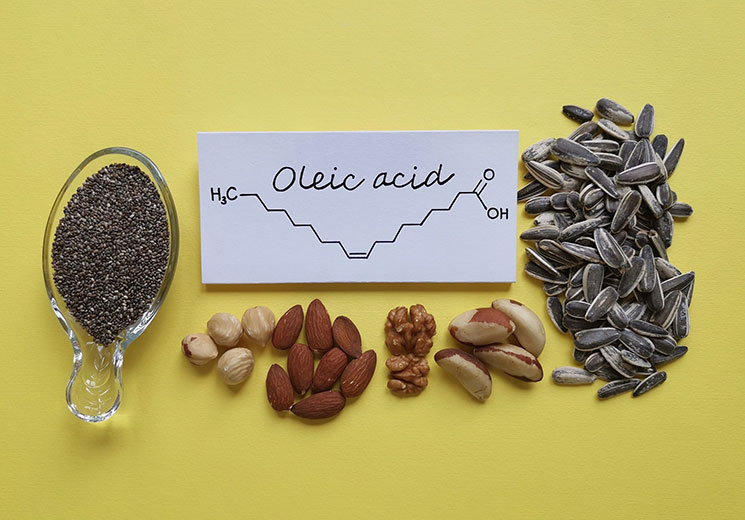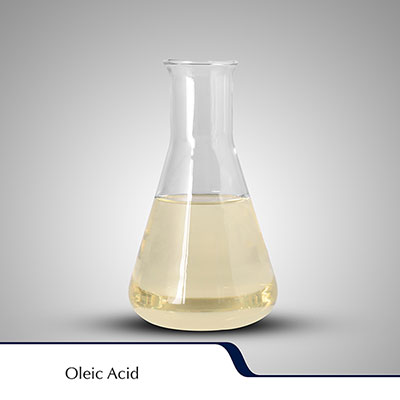Oleic Acid
Oleic Acid is a fatty acid that is naturally present in various animal and vegetable fats and oils. This acid is an odorless and colorless oil, but commercial samples are yellowish or brown.
What is oleic acid?
Chemically, oleic acid is classified as an unsaturated fatty acid. The name oleic is derived from the Latin word oleum meaning oil. Oleic acid is the most common fatty acid in nature. Oleic acid salts and esters are called oleate.
Oleic acid is the most common unsaturated fatty acid in nature. Fatty acids (or their salts) are often absent in biological systems as such. Instead, fatty acids such as oleic acid exist as their esters, usually triglycerides, which are the fatty substances of many natural oils.
This substance is found in fats (triglycerides), membrane-forming phospholipids, cholesterol esters and wax esters. Oleic acid is the most common omega-9 fatty acid and the most common unsaturated fatty acid. Oleic acid is the most abundant fatty acid in human adipose tissue, and is generally the second most abundant in human tissues after palmitic acid.
Table of technical specifications of oleic acid
| chemical formula | C18H34O2 |
| Appearance | Pale yellow brown oily liquid with a greasy smell |
| Melting point | 13°C – 14°C |
| Boiling point | 360°C |
| Molar mass | 282.468 g · mol − 1 |
| Dissolvability | It is insoluble in water.
Soluble in ethanol |
| Density | 0.895 g/mL |
The role of oleic acid in oils
Oleic acid triglycerides make up the majority of olive oil. Oleic acid makes olive oil inedible. Also 59-75% pecan oil, 61% canola oil, 67-36% peanut oil, 60% macadamia oil, 20-80% sunflower oil, 15-20% grape seed oil, buckthorn oil, 40% sesame oil, and 14% of poppy seed oil is also composed of oleic acid. This substance is present in many animal fats and it makes up 37-56% of chicken and turkey fat and 44-47% of pork contains oleic acid.
Production of oleic acid
The biological synthesis of oleic acid involves the action of the enzyme sterol. In fact, stearic acid is dehydrated to produce the monounsaturated derivative, oleic acid.
Oleic acid is affected by carboxylic acids and alkenes. This acid dissolves in aqueous solution and gives soaps called oleate.
The presence of iodine adds a double bond. Hydrogenation of the double bond produces the saturated derivative stearic acid. Oxidation of the double bond occurs slowly in air and is known as drying in coatings. Reduction of carboxylic acid group produces alcohol. Ozonolysis of oleic acid is an important pathway to azelaic acid. The common product of nanoic acid is:
H17C8CH=CHC7H14CO2H + 4″O” → HO2CC7H14CO2H+H17C8CO2H
Azelaic acid esters have applications in lubrication and emollients.
Applications of oleic acid
- As a triglyceride, oleic acid is used as an ingredient in many foods. It is part of the natural human diet, as it is part of animal fats and vegetable oils.
- Oleic acid as its sodium salt is one of the main components of soap as an emulsifier.
- It is also used as an emollient.
- Small amounts of oleic acid are used as excipients in pharmaceuticals, and as emulsifiers or solubilizers in aerosol products.
- Oleic acid is used to cause lung damage in certain types of animals in order to test new drugs and other methods for treating lung diseases. In particular, in sheep, intravenous administration of oleic acid causes acute lung injury with associated pneumonia.
- Oleic acid is used as a soldering flux in colored glass for lead bonding.
- Oleic acid is widely used in the solution phase synthesis of nanoparticles and acts as a kinetic knob to control the size and morphology of nanoparticles.
For more information and having consult on your desired product please contact our experts at Iran Petroleum.







Leave a Reply